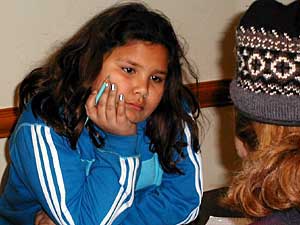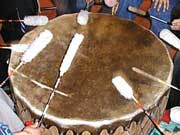Part 2: The seventh fire
August 20, 2003
 |
| Members of the Young Warrior Society. (MPR Photo/Dan Gunderson) |
Detroit Lakes, Minn. — Today, kids on the White Earth Reservation don't face the same struggles as Bob Shimek did. In schools and homes and forests, they are learning a way of life that was nearly destroyed. Kids are the heart of the spiritual revival in Indian country.
A half dozen children are gathered around a table doing homework at the Anishinaabe Cultural Center in Detroit Lakes. These kids are from the White Earth reservation. Some go to tribal schools, others attend public school.
Kids come to the center every afternoon. They learn Anishinaabe language. They participate in ceremonies and they get help with homework.
 | |||
An adult mentor reads as the kids work. The story blends science and traditional American Indian spirituality.
"The Ojibwe believe each plant has its own soul. A culture that believes plants have souls would not purposely destroy them. Plants are sacred beings. Each has an important purpose in creation," the story goes.
These children are part of a group called Oshkiianishinaabe, or the Young Warrior Society.
Many Anishinaabe people believe they will fulfill an ancient prophecy.
"Many centuries ago the Ojibwe lived on the Atlantic Ocean. Seven spirits came among the people and foretold the future of the tribe. These prophecies are called the seven fires."
Seven fires refers to seven ancient prophets. The first prophet told how Anishinaabe people would migrate to a land where food grows on the water. That's a reference to wild rice.
 | |||
Another prophecy predicted the coming of light-skinned people and an ensuing great struggle. The sixth prophet told how Indian people would suffer as they turned away from traditional beliefs and practices. The seventh prophet told of a rebirth of the Anishinaabe nation. He predicted a return to traditional ways.
Many believe today's children are the seventh fire.
"I can't believe that," says one child. "What can't you believe?" asks the teacher. "That we're the seventh fire," the child responds. "We are. We're the ones who are taking back our old ways. It's our responsibility to keep this alive, and we're living that today as we learn and read our stories and legends."
Lera Hethner is a fourth-grader in Detroit Lakes. She proudly wears a red jacket with an eagle emblem on the back. There's a different color jacket for each of four levels in the Young Warrior Society. Lera has reached the third level.
The Young Warriors must follow a code of conduct. They must be respectful. They must abstain from alcohol and drugs. They also must study traditional spirituality and practices.
 | |||
Lera says following a traditional path is difficult. She says she tries to offer tobacco and pray every day, but sometimes forgets. And sometimes it's hard to be quiet while elders talk. But she says she has experienced a spiritual presence in her life.
"I feel it when it's a big time and the Creator tells me stuff. His helpers come and talk to me. It's like having a little angel right by you, talking to you all the time," says Lera.
Lera says some of her public school classmates call her a goody-goody because she's respectful. She often hears disparaging remarks about Indian heritage.
"Sometimes I get treated differently and it doesn't feel right, but I just say that's OK with me," says Lera. "I just turn the other cheek and just let it pass through me and don't bother to worry about it, because it'll just bring me down."
The Young Warrior Society provides a support system and reinforces traditional Anishinaabe values. The kids also learn age-old skills like beadwork and drum making.
 | |||
"Hopefully that's tight enough," says Tom Mason, as he ties a wet rawhide over a drumhead.
"It's always hard to judge, when you tie a drum, if it's too tight," says Mason. "I like the bassy sound, like this sounds good here. When it dries it won't be so muffled. It'll be 'doong doong doong.'"
Tom Mason is 32. His long black hair is pulled back in a ponytail. Mason is one of the leaders of the Young Warrior Society. He's also lead singer for a drum group called Little Red Tail. Most of the drummers are teenagers. Today they're playing an honor song at Mahnomen High School's career day.
Mason says the drum is a way to teach the boys discipline. He says some were flirting with trouble when they were invited to join the drum.
"Some of those boys that sing on that drum used to be into this gang wannabe lifestyle, wearing the big jerseys and backwards baseball caps and talking the slang," says Mason. "When we invited them to sit on the drum, we told them we can't act like that. We need to come to the drum as Aniishinabe people and leave all that other stuff behind. Nowadays, none of them carry that attitude anymore. So that shows me that drum has made an impact on their lives."
American Indian communities suffer high rates of alcoholism, drug abuse and violence. Some say the social dysfunction is a result of the loss of traditional spirituality. They say the old beliefs provide needed moral guidance, a sense of belonging, and a committment to community.
There are many stories about Indian spirituality changing lives. Michael Dahl says he turned away from alcohol, drugs and gangs when he began to learn about Indian spiritual values. Dahl serves as a spiritual mentor to young people on the White Earth Indian Reservation. He says they are searching for a different way of life.
"They've had enough. They want to learn. They want to be Anishinaabe. They're tired of being Indians. They're tired of being Chippewa. They want to be Anishinaabe. They want to learn what that's about," says Dahl.
Dahl says to be Anishinaabe is to be reborn and live as the Creator intended.
|
News Headlines
|
Related Subjects
|

